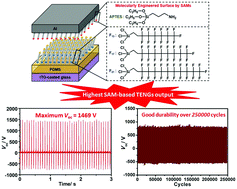Enhanced output performance and stability of triboelectric nanogenerators by employing silane-based self-assembled monolayers†
Abstract
Triboelectric nanogenerators (TENGs) that can harvest environmental mechanical energy have been considered as a promising solution in driving wearable electronics. In order to maximize the surface charge density, intense efforts have been devoted to the development of various geometrical micro-/nanostructures on the triboelectric surface. However, this approach generally has a low throughput and high cost, making it highly challenging for practical applications. In this study, we present a promising strategy to simultaneously enhance the performance and stability of TENGs by using silane-based self-assembled monolayers (SAMs). Silane-based SAM molecules, including fluorinated molecules with different numbers of fluorine (F) atoms and 3-aminopropyl triethoxysilane (APTES), are employed as the surface modification layer for the polydimethylsiloxane (PDMS) dielectric layer and the aluminum (Al) electrode, respectively. The trichlorosilane groups on these SAMs can hydrolyze to form a covalent bond with the substrate, providing the TENGs with admirable device characteristics. Among the fluorinated molecules investigated herein, the SAMs based on 1H,1H,2H,2H-perfluorododecyltrichlorosilane (F21) afford the highest output characteristics due to the most distinct difference in the ability to attract and transfer surface electrons from the Al layer to PDMS, delivering an open circuit voltage (Voc) of 600 V and a short circuit current (Isc) of 52 μA. The device performance can be further improved by incorporating APTES SAMs on the Al surface, and a Voc of 873 V and an Isc of 78 μA are attained. To the best of our knowledge, these characteristics represent the highest output performance ever reported for SAM-modified TENGs. Importantly, the resulting TENG also exhibits good durability, maintaining 96% of its initial voltage output after 250 000 cycles of repeated tests. More encouragingly, our strategy is also applicable for large-area TENGs. The present findings indicate that tailoring the atomic-scale interfacial properties plays an important role in the development of high-performance and stable TENGs.



 Please wait while we load your content...
Please wait while we load your content...